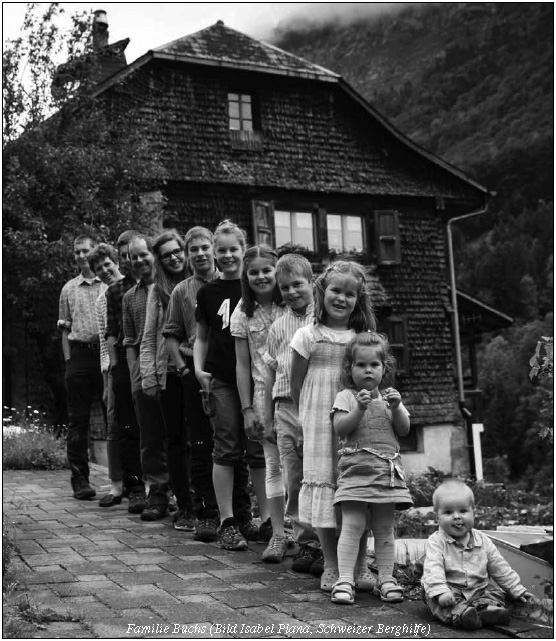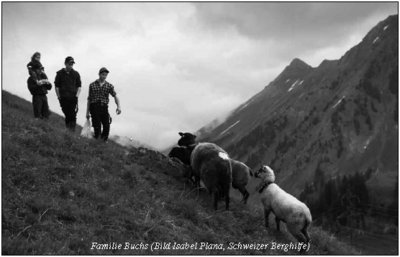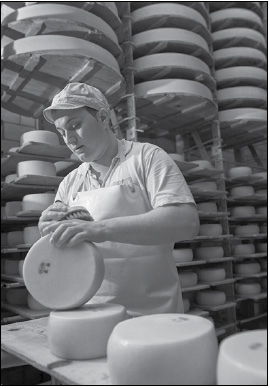Growing up in the mountains
Growing up in the mountains
by Max Hugelshofer, “Schweizer Berghilfe”*
Growing up in the mountains is great. The children have a lot of freedom, they are outside and get a feeling for nature. However, only if they learn a trade in their home country and later find a job, the mountain area remains alive. A glance at five Swiss families supported by the Swiss mountain aid and projects that contribute precisely to this.

Little Carina can not really talk yet. “Muuh”, she says when she sees a cow. Her bigger sister Ivana she calls “Ivi.” But at yodeling, Carina can be almost as good as a big one. When her eldest sister, Ramona, takes her on the lap and starts the song “Gloggejodel” with her, the two-year-old sings along enthusiastically. Making music is in the blood of the hill-farming family Buchs from Im Fang in the Canton of Fribourg. Father Patrick used to be a yodeler himself, and all the children are or were in the yodel choir. Actually, the Buchs family could have founded an own choir. The number of singers would not be lacking. Patrick and Monika have ten children, five boys and five girls, from 19-year-old Samuel to half-year-old Lukas.
Nobody finds this exceptional in the family. “There’s a family with twelve children nearby, and one up in the village with eight,” says Monika. “I myself grew up with ten brothers and sisters. This is nothing special here. “ It was always clear to Monika and Patrick that they wanted to have many children. How many exactly, was not that important. “I need life around me. It is exciting how each of our children has got their very own personality. And it’s nice to see them all developing in their own way“.
The children themselves react puzzled to questions about their many siblings. They have never thought about the fact that their family is not quite the average. The 14-year-old Stefan, who otherwise is no friend of long speeches, gets to the point: “Sometimes one of the brothers and sisters is annoying, but it is always nice to have someone close to you whom you are fond of.”
The children have all their own friends and hobbies: Magaly (11) and Ivana (12) play guitar, Christelle (9) and Yanick (7) love to play for ever with Lego. Ivana joins a ski club and wants to be a ski racer. But most often they are together with their family. This is already only due to the fact that there is very much to be done in the everyday life of the Buchs family. And all of them go along.
There is nothing more beautiful, than the work outside in the mountains
Our visit to the Buchs family took place on a Sunday since on an other day they would never be at home together. “On Sunday, we only do any work if it is absolutely necessary,” says Patrick. This means he gets up at 4 o’clock, drives to his parents’ home to milk the cows that are now placed there for the time being, thereafter to the self-leased Alp Gerstara where he milks the goats. At 6.30 a.m. Samuel comes also to the Gerstara to do the stable, while Patrick drives home with the milk cans in the car. He delivers the goat milk to the small court-dairy where Monika is already making the cheese. With the cow’s milk Patrick continues directly to Charmey, where he delivers it to the cheese dairy. At about 8 o’clock he is back home. Little by little the younger children have also gotten up in the meantime and arrive at the “Zmorgetisch” (breakfast table). Patrick has already got up again to continue working at the dairy, when Monika realises that Ivana and Magaly are soon to play the guitar at Sunday Mass. The transport is quickly organised.
Meanwhile, Patrick sets out with Stefan and little Carina to the nearby stable. There are two calves in the stable still to be fed. As they return, Emmanuel, the second oldest has arrived. He undergoes the agricultural traineeship in Rossens, in the French-speaking part of the canton. He has got to work today, but returns briefly home specifically for the photo session with the entire family. And since he is already here, he comes right along as Patrick, Stefan, and Carina drive to the second, even higher, Alp to look after the sheep grazing there.
When finally “Zmittag” (lunch) is at 12.30 p.m., the members of the Buchs family have already worked more than others on an entire working day. But that is everyday life for them, and no one is bothered by it. Not even Emmanuel. The 17 year old does not make a difference between leisure and work. “When I’m off, I help here in the yard”, he says. “I don’t need to go out, and I don’t like sitting around the room. There is really nothing more beautiful than being able to be out here in this wonderful mountain world.” He by all means wants to stay here in the valley. It is here where he grew up and is at home. At Fribourg, where he is currently absolving the apprenticeship, it is already too flat for him. “All of the cattle have moved to the alpine pastures of late and I was really envious of the cows. They are allowed up in the mountains and I have to stay down.”

Finding a good job is difficult
Growing up and live in the mountains is not at all easy. Especially for the parents. Finding a good job is more difficult than in the lowland. And to keep a job after the first child is often impossible for young mothers because there is no child care service available. In the Upper Vallais, a group of inhabitants have joined forces to change this. The result was the Children’s Daycare Center Gogwärgi named after an old word for a dwarf, where children are attended for one and a half years from the age of 6 months until starting school. In the afternoon and outside the school hours, school children are also cared for up to the age of twelve. Today, there are four children in the morning, who are supervised by daycare leader Brigitte Furrer and the two interns Kerstin Zurbriggen and Jessica Amstutz. Shortly before lunch, two more children join the group. They were in the kindergarten in the morning, which is housed in the same building – a former schoolhouse. Together, children and attendants have lunch. Thereafter the teeth have to be cleaned before one finally may continue. The two boys put together a Lego racing car in ever new variations, and the little girls hunt tirelessly through the playhouse and down the small slide.
Even if there are often a few tears on saying farewell to mommy, the children are fond of the “Gogwärgi” where they can get to know new friends to play with. “Unfortunately, my own children had very little contact with peers at this age,” says Dagmar Furrer, Fieschertal’s local councillor and president of the Children’s Daycare Center Gogwärgi. “Just for this reason alone I would have appreciated, had there already been a daycare center in my time. But, above all, I would have been glad to see the additional care offer.” For Dagmar Furrer, the daycare center is also an important instrument against the emigration. “If you want young families to stay here or even move here from outwards, you have to provide them with the necessary infrastructure.” Last but not least, the “Kita” (shortcut for “Kleinkindertagesstätte” (children’s daycare center)) is strengthening the Goms region because it has created four new jobs. Brigitte Furrer, the director of the daycare center, is also from the region, but had to move to the lowlands to pursue her profession. Now she was able to come back.
Care of children and adolescents in the Bernese Oberland
However, it is not just the children from the mountain area, for whom a daycare service is on demand. An example from the Gadmental in the Bernese Oberland shows a different kind of care for children and adolescents. Im Grin near Gadmen, Christian Feuz and Isa Oggier made a home out of a ruinous farmhouse. For themselves, for their three children and for a handful of adolescents and young adults who are not able to get along in society at the moment.
In the kitchen of this house Wuli fights with the bread kneading machine. The kneading hook absolutely will not engage. And that after the preparation of the dough was anything but easy, since he miscalculated badly the amount of water needed. But Wuli does not give up. He enjoys having success without any help. Even if it is demanding. The 16-year-old, whose complete name is Abduwali Dhiblawe, has grown up in different homes and has spent his former life more or less on the sofa. He did not know about day-to-day structures, and working intently is something new for him. He must learn both before he has a chance to find an apprenticeship, to gain a foothold in professional life and to integrate into society. In the remote hamlet Grin, near Christian and Isa, he has the chance to do so. “It’s strict, but I like it very much,” he says.
At the moment, Wuli is one of three young people who take part in the assisted living and working project. Moreover the former farmhouse is the home of Christian’s and Isa’s three children Lola, Elio and Maël. Together with one or two persons performing alternative civilian service (so-called “Zivis”) and the employee Pedro Burri, they form the Evergrin-Team. With so many people, there is lack of space. There are not rooms enough at all in the house. This is why a “Zivi” and Wuli are currently living in a self-rebuilt construction trailer. “We came to our first construction trailer when we had acute space problems”, Christian remembers. Out of necessity he made a virtue and built a room on wheels. Meanwhile, he and his people have become experts for such trailers and are also enhancing them on customer order. “It’s a very good job for our people. It is very versatile and satisfying because it is easy to see what has been done.” At all, the physical work for the people cared for is being considered an important component on the way to a more self-determined life. For example, the Evergrin-Team carries out gardening by order of a third party, maintains paths and refurbishes dry walls. About half of the income of the Feuz/Oggier family comes from these contracts, while the other half is paid for care allowances. At the moment the Evergrins are again busy with enhancing a new construction trailer. It is urgent, because soon a new person performing alternative civilian service will come, and he has to live somewhere.
Out of Wulis unruly dough has now become a sweet smelling bread. Also, he made two large bowls of salad, while Isa prepared a tarte flambée. At the lunch table, the whole Evergrin-Team comes together. They are reporting on the work in the morning, joking, chattering and planning the afternoon. And they are eating heartily, because it tastes good. Another success story for Wuli.

(picture Yannick Andrea, “Schweizer Berghilfe”)
Apprenticeships in remote areas
Particularly important for the mountain area and for the youth there is, of course, a good offer of apprenticeships. In many remote regions in the mountains there is a lack of this. Joel Wechsler from Luthern in the Napf area was lucky. He could do his apprenticeship as a milk technologist directly in the village, in the “Napf-Chäsi”. Since childhood it was clear to Joel that he would become a cheesemaker. At the age of ten, he wanted a little cheese kettle as birthday present and experimented with it on the parental farm. “It fascinates me, how many different foods you can make from milk,” says Joel. And he likes them all. “In our family, I am certainly the one who eats the most milk products. Surely, four kilos of yogurt a week and a lot of cheese.”
Getting the apprenticeship at the “Napf-Chäsi” (cheese factory) was not the only luck for him. The way to work is short and master cheesemaker Markus Stirnimann has steadily expanded the cooperative cheese dairy over the past decades and has included various specialties into the range of goods. This makes Joel’s work and training very versatile. Hard cheese, soft cheese, yogurt, butter – Joel already has produced everything in a wide variety. “Many of my mates from the vocational college (“Berufsschule”) are doing more or less the same year after year. I am glad, that this is different for me.” So Joel wants to remain true to the local cheese dairy. He already has discussed his future professional career with the boss: First, there are some “years of travel” for Joel to gain experience in other companies and to expand his horizons. Then he will return to Luthern. Anyway he can not imagine to live somewhere different.
Affinity with the mountain world
This affinity with the homeland is something that connects many adolescents and children from the mountain region. But how do youngsters from the flatland think about this? Could they live here? The apprentices of Reishauer AG from Wallisellen near Zurich have done the test. Once a year, they become “mountain movers”. One part of the apprentice training camp of this industrial enterprise has become an assignment in the mountain area since 1972. These assignments are coordinated by “bergversetzer” (mountain movers), the organisation for assingments in the mountain area, financed by the
“Schweizer Berghilfe”. This year the young men are working for the family Barbüda in Luchsingen in the Glarnerland.
The lamas of the family Barbüda peek somehow critical over their fence. From the house sounds clatter, clanking, laughter and shouting. Young people carry beams and doors behind corral of the lamas, rubble keeps falling from a window into a dumpster standing by. Barbüdas rehabilitate their house. But first the old flat has to be hollowed out. During the severe demolition work Barbüdas receive valuable help from the low-lands. 14 apprentices from the first year of their apprenticeship spend their time here. For one week, they live in a ski lodge nearby and help the Barbüdas. During the work on the construction site, they work hard and, by the way, get to know each other and their trainers better. “Such hard work forges a strong bond,” says Raymond Schneider. He must know, because he has been accompanying his apprentices to the camp for 30 years. “We’ve done a lot of different work,” says Raymond. “But demolition is best. Then the lads really can let off steam. We always like to be ordered for that kind of work.”
The youngsters enjoy the change to the everyday working life and show full effort despite the onset of muscle soreness on the third day. Some of them know the mountain area from holidays, for others it is a completely new experience to spend only a few days outside the agglomeration. “It’s nice, but I’m glad I don’t have to live here”, says one. “The people are all very nice. And I find it impressive how much Christian and his wife Barbara do themselves on their construction site”, says another.
Even if the work is hard and not always funny: For a long time the boys will keep the work in a good memory. And thus also the mountain area. Fabian Bucher, coordinator at “bergversetzer”, knows this from experience. “Everybody benefits from a work effort in the mountain region”, he says. The adolescents get an invaluable experience, the mountain people will be able to count on their understanding and solidarity for a lifetime. And the employer can carry out work for which otherwise the money would be missing. Christian Barbüda even cites figures: “A construction company offered me to do the demolition work for several tens of thousands francs. Plainly, we could not have afforded that”. The Reishauer apprentices have already moved mountains with their commitment to the Barbüda family. And they know that growing up in the mountain area is beautiful, but also challenging.
These examples show how much the support of mountain aid contributes to a living mountain region. “When children and adolescents benefit from this, our help will be particularly long-term”, says Regula Straub, Managing Director of “Schweizer Berghilfe”. “And when I look at these children and adolescents, I do not worry about our mountain region”. •
Reprinted with kind permission of “Schweizer Berghilfe”. First publication in Berghilf-Ziitig 2/2016, © Max Hugelshofer, “Schweizer Berghilfe”
(Translation Current Concerns)
*”Schweizer Berghilfe”
“Schweizer Berghilfe” (Swiss Mountain Aid) is an organisation exclusively financed by donations, with the aim of improving the livelihoods and living conditions in the Swiss mountain region.
It promotes the self-help of the mountain people, thereby contributing to the development of economy and habitats, preserving regional culture, cultivating the cultural landscape and counteracting emigration. In the year 2015, the “Schweizer Berghilfe” supported 513 projects with 23.8 million francs.
<link http: www.berghilfe.ch>www.berghilfe.ch
The projects
For each project presented in this article, you can find further information at www.berghilfe.ch, a gallery with further pictures and also a video of some projects.
Family Buchs, Im Fang/FR
<link http: www.berghilfe.ch imfang>www.berghilfe.ch/imfang
Children’s Daycare Center Gogwärgi
<link http: www.berghilfe.ch gogwaergi>www.berghilfe.ch/gogwaergi
Evergrin Gadmen/BE
<link http: www.berghilfe.ch grin>www.berghilfe.ch/grin
“Napf-Chäsi”, Luthern/LU
<link http: www.berghilfe.ch luthern>www.berghilfe.ch/luthern
Working with the family Barbüda, Luchsingen/GL
<link http: www.berghilfe.ch luchsingen>www.berghilfe.ch/luchsingen